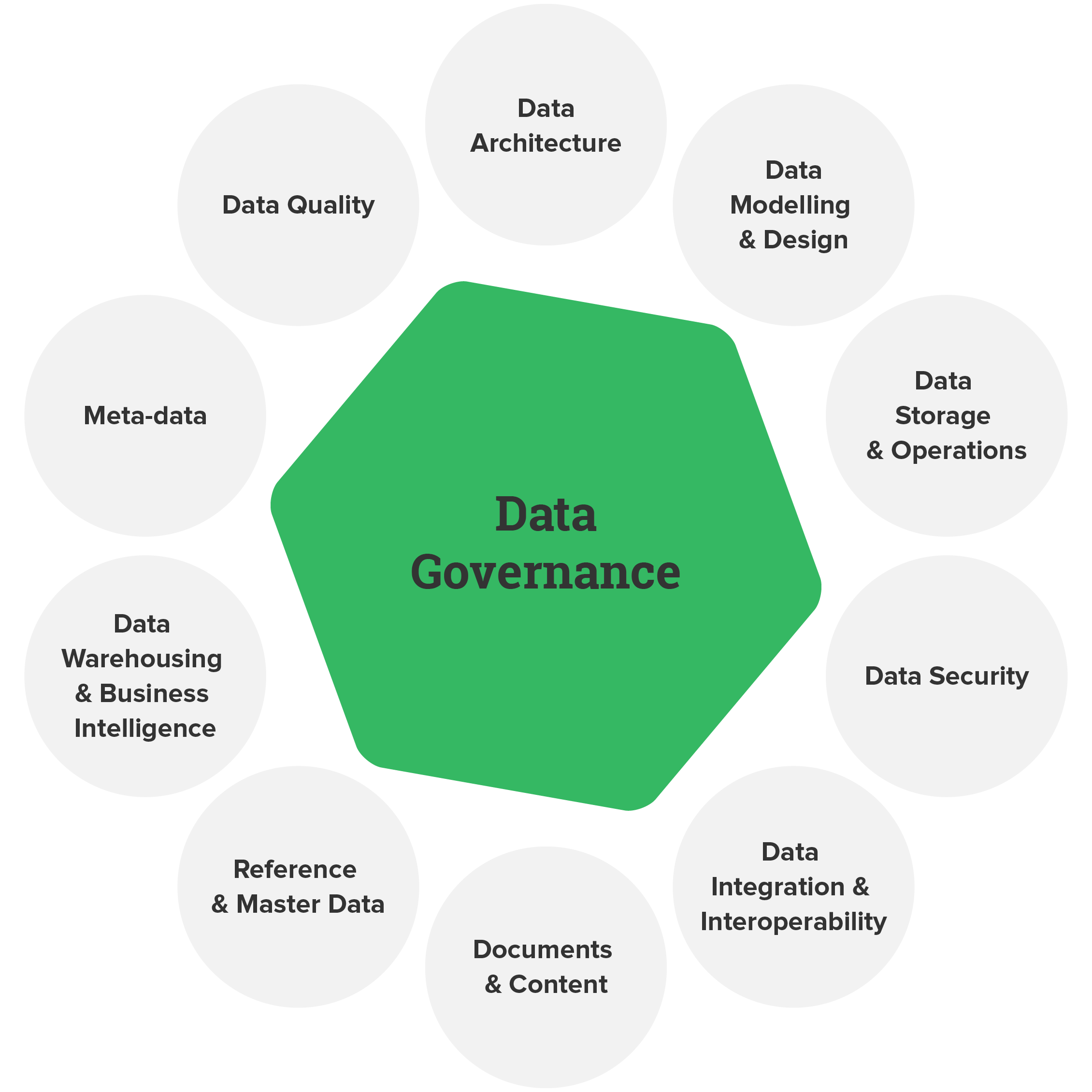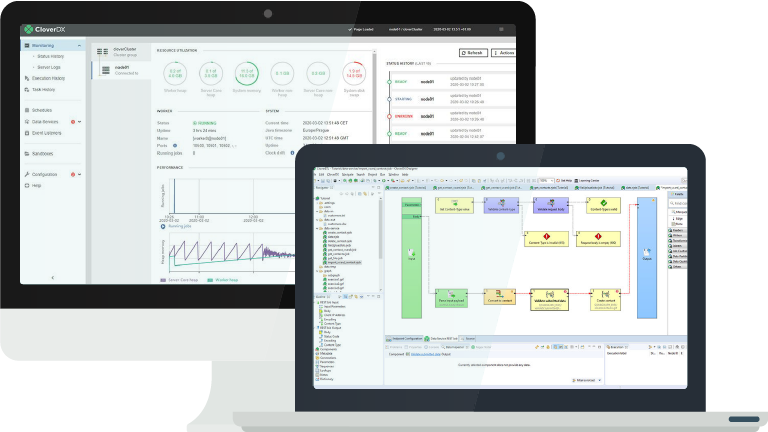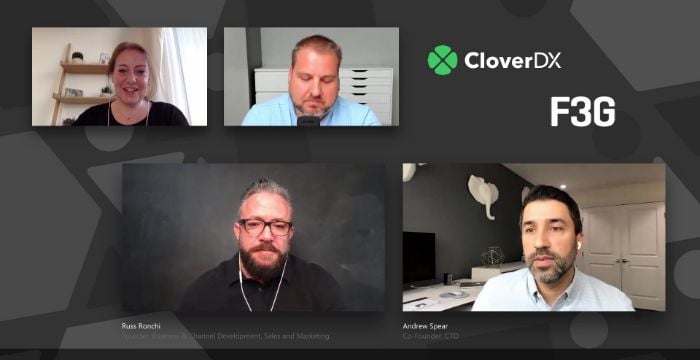
If you don’t keep on top of your data throughout its entire lifecycle, you run the risk of poor data quality, integrity, and security. This is bad news for innovative, forward-thinking businesses, especially in industries where meeting compliance regulations can make or break your reputation.
Fortunately, that’s why the process of data governance exists. But what does the term ‘governance’ mean, and how can you make it a reality in your organization?
In this guide, we’ll run you through everything you need to know about the data governance process, including an explanation of why it’s important, a look at the challenges you’ll face, and a step-by-step approach to successful implementation.
What is Data Governance?
Put simply, data governance is a negotiation between your organization and your data. It pertains to a set of universally defined policies, processes, and technologies that optimize the availability, usability, integrity, and security of all enterprise data.**
Without a resilient data governance framework, most businesses fail to manage their data efficiently. As a result, the quality suffers, and dirty, unstructured data begins to clog up your systems. At this point, you can’t rely on the data to provide valid insights or inform key decision-making processes.
While overall control and visibility is the driving force behind a well-designed data governance program, the discipline breaks down into several interconnected practices:

Mastering these practices makes it possible to standardize, integrate, protect, and store your data in line with strategic, operational, and regulatory expectations.
Blog: 5 Data-Driven Steps to Keeping your Regulators Happy
Sounds simple in concept. But, in practice, you’re likely to encounter a number of challenges. While this is expected in any data management strategy, you can overcome all business and technical roadblocks with a proactive and iterative approach to data governance.
Why Should Data Governance Matter to my Organization?
If you’ve led data management initiatives for a particular department or project, the term ‘governance’ will probably be familiar. Most teams implement informal rules dictating what happens to their data throughout its lifecycle. But this isn’t the same as a systematic framework.
As your organization scales, it becomes more challenging to implement cross-functional tasks efficiently. For example, if you're integrating millions of financial records across a network of banking systems, you can’t rely on hastily defined definitions and policies to ensure you meet regulatory standards. It’s just not possible to keep track of your data that way.
At this stage, you need a formal data governance policy and strategy to ensure your organization continues to meet its desired outcomes. These might include:
- Increasing consistency and confidence in decision-making
- Decreasing the risk of regulatory fines
- Improving data security or transparency of data lineage
- Making sure you're complying with data privacy rules
- Maximizing the revenue potential of your data
- Eliminating the need for rescoping and project extension
- Optimizing staff productivity or process efficiency

Strong data governance is also vital to business innovation and process transformation. Remaining responsive and open to new data capabilities is critical to fending off fierce competition, but relying on outdated or backward-thinking structures can harm your chances of success.
The following data innovations will have a huge impact on your current business processes:
In each case, a lack of data governance can prove costly, resulting in poor data quality, insurmountable business silos, and complex and time-consuming reconciliation projects.
The 3 Challenges of Implementing True Data Governance
Despite the push to build company-wide data cultures, 69% of respondents to one survey said they are still failing to become ‘data-driven.’ The use of this terminology is a core part of the problem.
The word ‘data-driven’ implies that you take a backseat to your data’s fate – the exact opposite of what data governance best practices state we should do.
The ultimate goal is to retain complete control of your data, no matter where it sits in your enterprise architecture. You’re the one behind the wheel.
Of course, implementing this data governance philosophy is easier said than done.
Let’s look at a few key obstacles you’re likely to face along the way.
1. A closed organizational culture
People are just as integral to the success of your data governance program as the technology you use. Launching and sustaining new governance projects can be difficult if your workplace culture is resistant to change. Real problems occur when no defined data quality standards or clear ownership exists. In this situation, datasets begin to diverge, data silos emerge, and there is no single definition of what the data represents.
This is a tricky challenge and requires careful negotiation, but it’s also an essential step in your overall strategy. To eliminate the need for expensive reconciliation processes, you need every department, function, and employee to work within the same data governance framework.
Blog: Solving data sharing in a hybrid working world
2. Limited stakeholder buy-in
While securing the enthusiasm of the wider company is one thing, engaging stakeholders is an entirely different beast. Low-level, non-threatening changes to data management are often welcomed by senior execs. But more considerable shifts to the status quo are harder to get across the line.
Large data governance projects require carefully balancing resources, budgets, and timescales. So, your bosses need to understand the business value of a complete data management overhaul.
Enabling transparency of your data – for example, by using data modeling tools and processes – is an excellent way to engage the executive team more in the process and empower them.

3. Lack of standardization or maturity
It pays to be flexible and fast-moving in today’s competitive business landscape. But this shouldn’t come at the expense of your data governance standards. There’s a fine line between responsiveness and poor standardization – one that will quickly blur if the right processes aren’t in place.
A lack of alignment between data ownership and specific business divisions leads to a mess of black-box data processes. With no enforced standards, the movement and modification of your data quickly becomes a free-for-all – much like a bus station without a consistent timetable.
Over time, every business function ends up with its own interpretation of the same data. Institutional knowledge becomes fragmented and lost in a sea of scripts, transformations, and mappings. And, without a single version of the truth, it’s virtually impossible to track data lineage and ensure your data pipelines remain efficient and auditable.
Read more: How to Regain Control of Your Data Auditing Process (6 Best Practices)
8 Steps to Building an Effective Data Governance Strategy
While change of this magnitude certainly won’t happen overnight, building an effective data governance strategy can be the difference between success and failure.
Blog: How To Future-Proof Your Regulatory Compliance Strategy
The good news is that you probably already have much of this strategy in place. But that doesn’t mean you can rest on your laurels. Following an established data governance framework will help you benchmark your current strategy against successful models. This will ensure you’re not overlooking vital policies or procedures.
Here are our eight essential steps to building an effective data governance strategy:
- Understand your corporate drivers and clearly define data management goals
- Analyze the current state of your enterprise data management and prioritize areas for improvement
- Maximize the availability of information by using data integration tools to consolidate data from disparate and diverse architectures
- Create your new data governance policies and assign roles, responsibilities, and rules
- Ensure data quality and integrity by profiling, parsing, standardizing, enriching, and monitoring all information
- Establish accountability and assign ownership of each information asset
- Convert to a master-data culture where a single ‘system of record’ provides a unified, consistent, and accurate view of all entities
- Develop a feedback mechanism and promote continuous process improvement by using real-time monitoring tools
These steps become particularly important as your organization and data projects scale. The proliferation of data across multiple applications, systems, and architectures makes a single version of the truth more challenging to obtain but by no means impossible.
With the right data governance tools and policies, you can unite business objectives and technology initiatives and continue to make measurable improvements.
Choosing the Right Data Governance Tools
Many companies still rely on manual processes to profile, validate, and monitor their data. But for larger organizations, this is no longer an option.
Despite our best intentions, human error almost always creeps into data processes. These errors lead to false, fragmented, or duplicated information. At a smaller scale, this is easily spotted and corrected. However, as projects and ambitions grow, so does the complexity of data management.
Eventually, you end up where institutional knowledge is lost in a sea of different data transformations, scripts, and interfaces.
Fortunately, automated data governance tools eliminate this problem. When evaluating these tools, the following criteria will help you identify the best technology for the job:
- Can this tool identify and track common create, read, update, and delete activities for data elements?
- Can it provide effective data quality management (i.e., rules, profiling, reporting)?
- Can it perform data movement, data lineage views, and positioning?
- Does it provide metadata support for document classification and document lifecycle management?
- Does it assign and manage governance roles and responsibilities?
- Does it define and monitor service-level agreements, issues, and activity statuses?
- Can you define and manage data management workflows and track progress of data governance activities?
- Can you monitor business strategies and plans and calculate the business value of data?
In many cases, you won’t find a single tool that meets all these criteria. You might instead opt for a series of connected data governance tools that provide a complete data governance pipeline – from data modeling through integration and transformation to reporting and visualization.
Webinar: Turn Data Models into ETL Jobs at the Click of a Button
Don’t Start With a Big Bang
Any data integration initiative should be driven by business goals, not IT. The project needs a thorough analysis of the requirements so it can be designed to achieve that. This includes having a business champion who understands the company's data assets and can lead discussions about the long-term aims of the data integration project.
Data is here to stay. And you’ll always need a way to keep on top of it. Competitive pressures, internal and external risk, and an ever-changing regulatory landscape mean that solid data governance is as much a business priority as cash flow or R&D.
While there is a clear need for rapid and consistent change, you can’t expect to reinvent the wheel in one afternoon. By taking a practical and measured approach to data governance, you can take greater control of your data and move towards a single version of the truth.
Just because you’re not starting with a big bang doesn’t mean you can’t make rapid progress. With the right approach and transformation tools, you can significantly reduce the time it takes to implement your data governance strategy and supercharge your business operations.

Data Governance with CloverDX
As the volume and complexity of your data increases, so does the difficulty of maintaining visibility and ensuring compliance. Perhaps more than anything else, data governance is a marathon rather than a sprint. It’s not a ‘one-and-done’ task. It takes dedication and consistency to keep your data compliant.
By rethinking the ways your organization treats its data, it becomes possible to:
What the process looks like
Data governance goes hand in hand with your data integration strategy – or it certainly should. The more visibility and control your organization has over its data, the easier compliance can be.
For example, are your data owners, technical, and governance teams all using different tools? Siloed working can result in your data quality degrading and poor decision-making due to lack of communication. CloverDX empowers you to gain more value from your data, all while incorporating governance as part of your strategy.
The best way to keep regulators happy and fulfill security obligations is by building your own compliance strategy, taking full advantage of the transparency and lineage that successful integration delivers.
Not only will this meet governance requirements, but provide an informed and valuable foundation for change within your business.
Compliance challenges aren’t obstacles to achieving your goals; look at them as an opportunity to strengthen your data pipeline, free up time, lower costs, and achieve more for your business.
Click here to learn more about how CloverDX helps you minimize risk and achieve compliance.
We can help
Our demos are the best way to see how CloverDX works up close.
Your time is valuable, and we are serious about not wasting a moment. Here are three promises we make to everyone who signs up:
- Tailored to you. Every business is unique. Our experts will base the demo on your unique business use case, so you can visualize the direct impact our platform can have.
- More conversation than demonstration. Have a question? We want to hear it. Ensuring your business stays compliant without compromising efficiency can feel daunting. We want to hear your concerns and find a beneficial way forward for your organization.
- Zero obligation. We’ve all been there. You spend some time hearing about a product or service… and then comes the hard sell. Our team doesn’t ‘do’ pushy. We prefer honest, open communication that leaves you feeling informed and confident.
Get in touch for a personalized demo.








